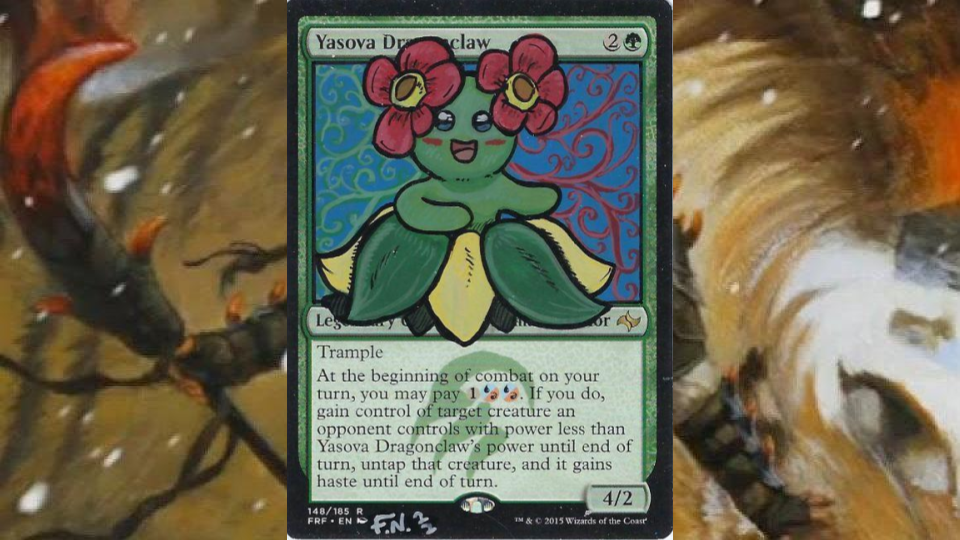Pokedecks: Yasova, the Bellossom

Got them Moves Like Swagger
While linear decks, like Voltron and kindred strategies, are a lot of fun to build, their play patterns can get rather stale after a while. Sometimes, it's fun to make a deck that can shake things up, and who better to shake things up than a fancy dancing alternate evolution to an old-school favorite?
Removal in Commander games can be a bit of a contentious topic. Personally, I've been cutting removal from decks because, while winning is fun, removal rarely seems to add much to games besides length. Often, I wind up leaving removal in hand and letting someone win in a fun or original way, even if I could have stopped it, based on the Dungeons and Dragons "Rule of Cool". But how can we keep removal in the deck while maintaining excitement? It's Yasova to the rescue!
Polymorph
Polymorph doesn't specify WHOSE creature is destroyed. I have a Djinn kindred deck designed to aim Polymorph effects at opponents' creatures in order to use this as a mechanical version of the double-edged sword that is a Djinn's wish-granting ability. In this deck, the Polymorph effects are used to set up Threaten
Swagger and Flatter are both abilities that function similarly to the Polymorphing threats strategy. Both Pokemon moves strongly increase an opponent's offensive stats, which can be dangerous, just like when we draw opponents' threats out. Both moves also come with the confusion condition, which reverses the offensive force and can use it against them. Swagger is a fairly popular move, so why Bellossom in particular? Bellossom is a dancing Pokemon in a Hula skirt of colorful leaves, and its taunting, beguiling dance reminds me of the "Big Pig" scene from The Lion King, where Timon and Pumba use a Hula dance to distract and taunt a horde of hyenas.
Yasova's Abilities
Despite only having a green pip in her casting cost, Yasova is considered to be a Temur commander. Like Alesha, Who Smiles at Death
Insurrection
Reins of Power
Mob Rule
Bellossom's Moves
Swagger is a move that increases the opponent's potency with the aim of reversing it on the opponent. It rides a thin line between political support and unassuming reversal-based offense. How do we show this ability to draw out the opponent's latent power to complement Yasova's Threaten effects?
Oath of Druids
Proteus Staff
Spellshift
So...we've got eight-mana game-breaking spells, four-mana removal spells, and a commander that requires mana to activate. How are we going to afford all this? The answer is the same as that for most green decks: RAMP.
The Perfect Fusion
The deck does a great job of producing threats out of other decks, seizing control of them, and redirecting them towards the opponent. The pieces fit together nicely, creating a gameplan based on riding the exciting line between powering opponents up and succumbing to the power we've bestowed on the board. But power creep is real, and it's entirely possible that we could get overpowered if there's too much time between the mesh points of the strategy.
Cursed Mirror
New Frontiers
Tempt with Discovery
Yasova, use Swagger!
Here is the most recent iteration of the deck, which is still one of my favorites.
How do you feel about Chaos and Group Hug decks? And how do you determine whether they're exciting or frustrating?
Yasova Swagger
View on ArchidektCommander (1)
Creatures (3)
Sorceries (34)
- 1 Act of Treason
- 1 Besmirch
- 1 Chaotic Transformation
- 1 Collision of Realms
- 1 Cultivate
- 1 Edge of Autumn
- 1 Far Wanderings
- 1 Farseek
- 1 Harness by Force
- 1 Hate Mirage
- 1 Indomitable Creativity
- 1 Insurrection
- 1 Kari Zev's Expertise
- 1 Kodama's Reach
- 1 Life from the Loam
- 1 Lose Calm
- 1 Mark of Mutiny
- 1 Mass Mutiny
- 1 Mob Rule
- 1 New Frontiers
- 1 Nissa's Pilgrimage
- 1 Nissa's Renewal
- 1 Pir's Whim
- 1 Polymorph
- 1 Portent of Betrayal
- 1 Rampant Growth
- 1 Reality Scramble
- 1 Shape Anew
- 1 Show and Tell
- 1 Tempt with Discovery
- 1 Threaten
- 1 Three Visits
- 1 Traitorous Blood
- 1 Transmogrify